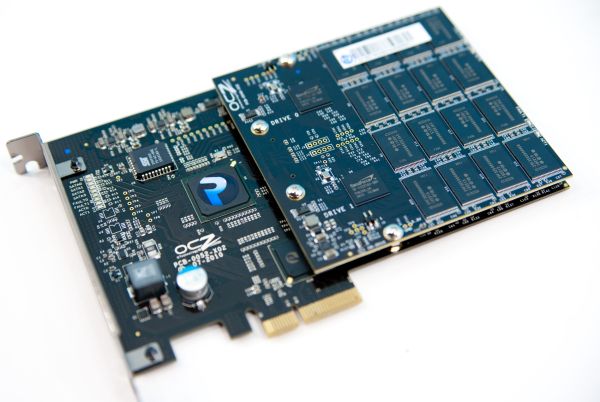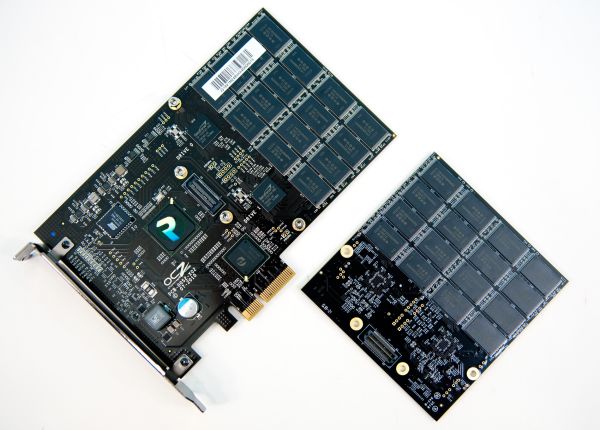A Quick Look at OCZ's RevoDrive x2: IBIS Performance without HSDL
by Anand Lal Shimpi on November 4, 2010 1:05 AM EST- Posted in
- Storage
- SSDs
- OCZ
- RevoDrive
- RevoDrive x2
A week after I previewed OCZ’s IBIS and the HSDL interface, SandForce revealed the specs of its next-generation enterprise SSD controller. The specs for the SF-2000 series call for up to 500MB/s sequential reads and writes, nearly saturating the newly introduced 6Gbps SATA bus. It should be no surprise that OCZ is very interested in moving away from SATA.
We met OCZ’s first PCIe based SSD two years ago with the Indilinx based zDrive. Take four Indilinx Barefoot controllers, RAID them together on a PCIe card and you’ve got a zDrive. The first SandForce based PCIe solution actually took a step backwards: the OCZ RevoDrive only used two SandForce SF-1200 controllers.
Performance was of course much better than the old zDrive. SandForce has all but put Indilinx out of our minds (and systems). But the recently announced IBIS and the suspicious unpopulated connector on the original RevoDrive made it clear that there was room for more performance.
Meet the RevoDrive x2:
Identical to the original RevoDrive in every way, the x2 adds a second PCB complete with two more SF-1200 controllers. With a total of four SF-1200s on board, running in RAID-0, you should get IBIS-like performance without the HSDL interface.
The architecture remains unchanged. To save on costs OCZ uses a PCI-X based RAID controller: the Silicon Image 3124. The 3124 has four independent SATA ports, each one connects to a SF-1200 controller.
Between the Sil3124 and the PCIe x4 interface is a Pericom PCI-X to PCIe bridge. It converts the parallel PCI-X signaling into serial PCIe. The Sil3124 can deliver 1GB/s of bandwidth to the Pericom bridge, as can the 4 PCIe lanes (1GB/s in each direction) so there are no interface bottlenecks here. A quartet of SF-1200 controllers can’t realistically push more than 1GB/s of data.
As with all RAID enabled solutions, there’s no TRIM support but you do get idle garbage collection.
There’s no performance advantage over you running four of your own SF-1200 based SSDs in RAID-0. The RevoDrive x2 is pretty much a four drive SF-1200 SSD on a stick for those who want simplicity.
The previous RevoDrive was supposed to be cost competitive with a two drive RAID array. Today, looking at pricing, a 240GB RevoDrive sells for $519 while a pair of 120GB Vertex 2s will set you back $480. You pay a premium for the simplicity but performance is identical to rolling your own SSD RAID setup.













46 Comments
View All Comments
disappointed1 - Thursday, November 4, 2010 - link
Of course, DMI itself is "a (perhaps modified) PCI-E x4 v1.1 interface"disappointed1 - Thursday, November 4, 2010 - link
oops, Intel block diagrams depict that as 2GB/sStuka87 - Thursday, November 4, 2010 - link
That bandwidth isn't dedicated to the drives though. Its shared with other devices.leexgx - Friday, November 5, 2010 - link
intel ICH max's out at around 700-800MB/s with RAID 0 more ssds does not add muh more data rate {adds maybe 20-50MB/s per extra ssd}(random access speed mite be higher), it has been testedGooger - Thursday, November 4, 2010 - link
Fusion IO seems to have the right idea by (according to them) getting rid of the raid controller (aka the middle man) and feeding the data directly to the bus. Perhaps it's time OCz and others start looking at their approach to things.http://www.fusionio.com/
disappointed1 - Thursday, November 4, 2010 - link
They're not bootable and cost thousands of dollars - totally different market segment.disappointed1 - Thursday, November 4, 2010 - link
Thanks for a more straightforward review Anand. Since this is largely the same as the previously-reviewed IBIS, I think in addition to rehashing those benchmarks, it would be more interesting to get hard data on your claim that..."The reality for OCZ however is there’s no performance benefit to purchasing a RevoDrive x2 over four Vertex 2s and creating your own RAID array"
I'd love to see what 4x SF-1200 drives do on an ICH10R, or a discreet RAID card running off the IOH.
RealMurphy - Thursday, November 4, 2010 - link
* Drive is able to sustain massive read bandwidth - check* Drive is able to sustain massive write bandwidth - check
* a lot of IOps - check
* but why the heck PCI-X? Unless I'm totally mistaken and this is one of the few PCI-X 2.0 devices, you have NO error correction what so ever on this path and only puny even parity checking which will eventually fail and let's you read/write junk :( (caveat, maybe I misinterpret the PCI(-X) specs, if so please correct me)...
Powerlurker - Thursday, November 4, 2010 - link
Supposedly, it's because OCZ realized that a PCI-X controller plus PCI-X to PCIe bridge cost significantly less then a native PCIe RAID controller.ypsylon - Thursday, November 4, 2010 - link
Bad investment and misguided. You can easily achieve these results with basic software RAID card (like Highpoint Rocket RAID 6xx) and 4 cheap SSDs. And if you buy proper RAID controller (say Areca 1261ML) and plug anything between 4 and 16 small SSDs in RAID 0 or 10 you will simply trounce Revo in every possible way. While it is more expansive short term, you can always freely expand storage space with bigger SSDs without too much hassle. You can't do that with Revo.Honestly SSDs are still a premium product. And for a premium product Revo is not good enough. I would certainly buy Photofast GM-Powerdrive, not Revo. Of course it is more expansive (2.5x) but it offers twice the performance (PCI-Ex x8 not x4 like in RevoDrive), and full hardware RAID support from R0 to 60 (not some software rubbish from SilImg, brrr).
I like the idea of the FusionIO, but it is not for normal PC users. It is fine investment tho if you own gold mine, oil derrick, first name is $heikh, you are footballer, work for a mafia, or you are a banker. Take your pick! ;)